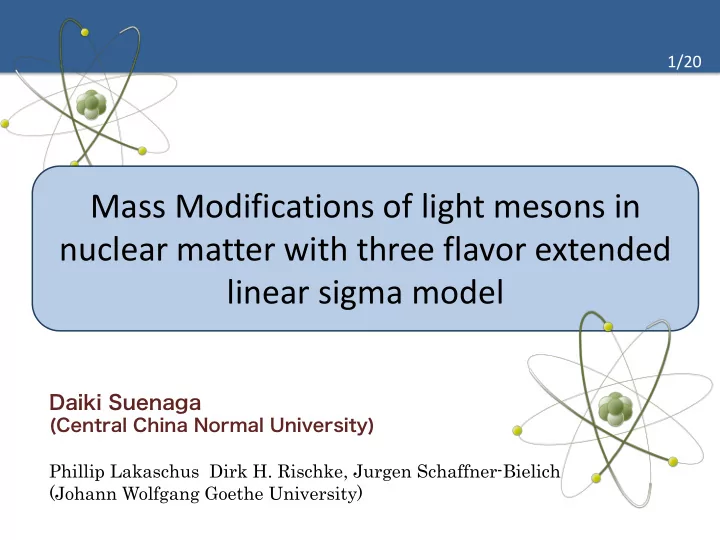

(Central China Normal University) Daiki Suenaga 1/20 Mass Modifications of light mesons in z nuclear matter with three flavor extended linear sigma model Phillip Lakaschus Dirk H. Rischke, Jurgen Schaffner-Bielich (Johann Wolfgang Goethe University)
・Mesons in nuclear matter 1. Introduction 2/20 � ������������������������������������������������������������� related to… (Theoretically) Partial restoration of chiral symmetry, Change of axial anomaly, etc… (Experimentally) Modification of vector mesons experiments Mesic nuclei, etc… � ������������������������������������������������������������������� comprehensively within a chiral model in a unified way
・Extended Linear Sigma Model (eLSM) 1. Introduction 3/20 � The extended Linear Sigma Model (eLSM) is a chiral model which can reproduce light meson properties successfully D. Parganlija, P. Kovacs, Gy. Wolf, F. Giacosa, and D. H. Rischke; z PRD 87, 014011 (2013) Includes 9 scalars, 9 pseudo-scalars � 9 vectors, and 9 axial-vectors (and 1 dilaton) � We applied the eLSM into cold nuclear matter reproducing saturation properties and studied mass changes of the mesons in nuclear matter comprehensively
2. eLSM ・The eLSM 4/20 D. Parganlija, P. Kovacs, Gy. Wolf, F. Giacosa, z and D. H. Rischke; PRD 87, 014011 (2013) � (2 quark state) meson field is schematically written by q j Φ ij ∼ ¯ R q i �������������������������� L q j q j R ij R γ µ q i L ij L γ µ q i ������������������������� µ ∼ ¯ µ ∼ ¯ R L chiral transformation laws and particle assignment � SU (3) L × SU (3) R Φ → g L Φ g † R R µ → g R R µ g † R L µ → g L L µ g † L
2. eLSM ・Lagrangian 5/20 D. Parganlija, P. Kovacs, Gy. Wolf, F. Giacosa, z and D. H. Rischke; PRD 87, 014011 (2013) � The Lagrangian is given by � ���������������� R µ ν = ∂ µ R ν − ieA µ [ T 3 , R ν ] − ∂ ν R µ + ieA ν [ T 3 , R µ ] L µ ν = ∂ µ L ν − ieA µ [ T 3 , L ν ] − ∂ ν L µ + ieA ν [ T 3 , L µ ] � ��������������� D µ Φ = ∂ µ Φ − ig 1 ( L µ Φ − Φ R µ ) − ieA µ [ T 3 , Φ ] ��������������� � Axial anomaly
・Input parameters 2. eLSM 6/20 D. Parganlija, P. Kovacs, Gy. Wolf, F. Giacosa, z and D. H. Rischke; PRD 87, 014011 (2013) � �������������������������������
・Input parameters 2. eLSM 7/20 D. Parganlija, P. Kovacs, Gy. Wolf, F. Giacosa, z and D. H. Rischke; PRD 87, 014011 (2013) � � ������������������������������ � ���� ����������������������������������������������������������������������� ���������������������������������������������������������
2. eLSM ・ fitting 8/20 χ 2 D. Parganlija, P. Kovacs, Gy. Wolf, F. Giacosa, z and D. H. Rischke; PRD 87, 014011 (2013) C 1 = m 2 0 + λ 1 ( φ 2 N + φ 2 S ) 1 + h 1 C 2 = m 2 2 ( φ 2 N + φ 2 S )
Recommend
More recommend